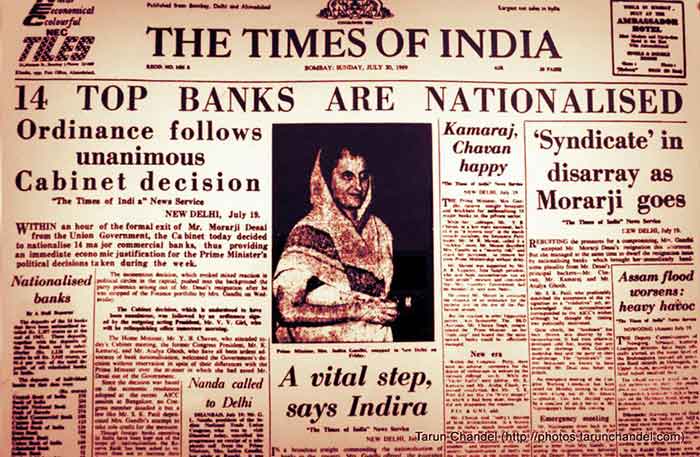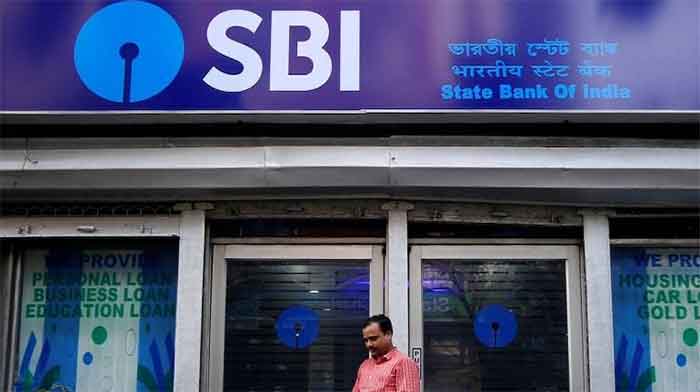Co-Written by Tanya Singla and Achintaya Soni

Introduction
July 19, 2020 marked the 51st anniversary of the Banking Companies (Acquisition and Transfer of Undertakings) Ordinance, 1969. Simply termed the Banking Nationalization Ordinance of 1969, it announced the taking of ownership and control by the State of 14 commercial banks namely Allahabad Bank, Bank of Baroda, Bank of India, Bank of Maharashtra, Central Bank of India, Canara Bank, Dena Bank, Indian Bank, Indian Overseas Bank, Punjab National Bank, Syndicate Bank, UCO Bank, Union Bank of India and United Bank of India. These 14 banks en masse made about 75% of the total banking sector in India at that time.
Being one of the most closely-guarded secret moves, the decision was completely unanticipated and was moved ostensibly in pursuance of socialism and rural development. Ruminating over the possible -consequent losses, corruption and red-tapism, the decision was vehemently opposed by the rival political parties like Swatantra Party and Jan Sangh. The matter was also taken to the Supreme Court by Rustom Cavesjee Cooper through a prominent lawyer and ‘the courtroom genius’ Nani Palkhivala who filed the petition in the Apex Court on the very next day. This led to an interim order by the Supreme Court restraining the Government from removing the Chairman of all the banks which had been nationalized. Meanwhile, on August 8, 1969, the concerned ordinance was replaced by Banking Companies (Acquisition and Transfer of Undertakings) Act, 1969. The director of Central Bank of India and a shareholder of Bank of Baroda and Bank of India, R.C. Cooper alleged the Act to be violative of his fundamental rights articulated in Articles 14, 19 (1)(f) and 31(2) of the Indian Constitution and ergo, Mr. Palkhivala then challenged the constitutionality of the legislation. He argued that the compensation payable under Schedule II of the Act to the erstwhile shareholders of the nationalized banks was grossly inadequate and thus violative of Article 31 of the Constitution.
The honourable Supreme Court in its judgment, delivered in R.C. Cooper v. Union of India[1] on February 10, 1970, upheld the power of Government to nationalize any industry including banks, however, Palkhivala’s argument on violation of Articles 14, 19(1)(f) and 31 were accepted. Therefore, the Banking Companies (Acquisition and Transfer of Undertakings) Ordinance, 1969 failed the scrutiny of constitutionality and was declared to be invalid. This led to a fresh legislation providing for the nationalization of banks.
An Unnecessary Use of Power?
In a democracy, where people are believed to possess the ultimate power, it becomes well-nigh mandatory that all legislative decisions are taken by the representatives directly chosen by people, for; the legislations are ordained to affect their lives or livelihoods directly. Albeit our constitution confers the legislative powers upon the President too, but at the same time there are conditions attached to the exercise of this power. While providing for the ordinance promulgating power to the President, Article 123 of the Constitution univocally asserts that the President should resort to the promulgation of ordinance only if and when both the Houses of Parliament are not in session and there exist some exigencies which force the President to take immediate action.
Harking back to the times when Banking Companies (Acquisition and Transfer of Undertakings) Ordinance, 1969 was promulgated by the then Acting President V.V Giri, though India at that time was stuck amid various whammies namely the two international wars, one with China in 1962 and another with Pakistan in 1965, and two consecutive years of drought, there was no urgency per se on the night of July 19, 1969, to promulgate an ordinance and that too, when the Parliament was supposed to hold a session just two days later on July 21, 1969. Moreover, the ordinance was drafted secretly and in haste, by S.K. Maitra in consultation with P.N. Haskar, L.K. Jha and I.G. Patel. Also, the ordinance, when presented before the cabinet on July 18, 1969, was approved without any discussion and deliberation. The amalgamation of all these factors set the democratic and constitutional norms at naught and points towards the unnecessary and excessive use of power. Although it may be in the limits of the government to nationalize banks or any industry as upheld by the Supreme Court in R.C. Cooper v. Union of India[2], it does not possess any power to deviate from the constitutionally established requirements and processes.
After-effects of Nationalization of Banks: Socio-economic
Considering the after-effects of Banks’ Nationalization, one may realize that the decision itself was not a subterfuge. The erasure or emendation of some of its provisions has indeed made it a good decision and it has also been able to yield some calculated favorable results.
Earlier in the pre-nationalization era when private individuals or organizations used to rule the roost, banks were extending credit to large scale industries which were usually owned and controlled by the large industrial houses. On the other hand, the government priority sectors such as agriculture and small-scale industries were put on the back burner. But in the post-nationalization era, the narrative took a U-turn. The gross bank credit extended to the priority sector surged from 14% in July 1969 to 30.3% in July 1979.
Also, in the pre-nationalization era, bank branches and consequently banking services were not accessible to rural and semi-urban people due to which the deposits of a considerable number of people could not be attracted by the banks. Banks’ Nationalization reversed the destiny of rural and semi-urban areas too. In 1969, the rural bank branches accounted for 22.4% of the total bank branches and it increased to 36.3% of the total in 1975 and by 1984, these branches accounted for 56% of the total bank branches in the country at that time. Gross domestic savings as a part of national income also got doubled in the 1970s.[3] While working for the economic advancement of rural areas and the people residing therein, this decision also attempted to push rural people upward on the social basis and bring them at par with their urban counterparts.
At the same time, it is asserted that nationalization of banks was done to cut the tranche of credit available to big businesses which were believed to support the rivals of Indira Gandhi. Also, the system of credit extension became enigmatic because there were different interest rates for different loans. RBI was overburdened with work because it had to manage hundreds of interest rates while performing other tasks. This was later done away within 1991 when the central bank decided to assess a pivotal repo rate while the lending rates were left to be decided by the commercial banks themselves.
Conclusion
It always rests upon the time to decide the ramifications of a decision, what is essential at the initial stage of making a decision is that the decision is carefully calibrated and is put in operation by following the due process. This was the aspect that the government failed to take into consideration in 1969. Analysis of the process through which Bank Nationalization Ordinance was promulgated tells us that the move while being in utter disregard of constitutional, parliamentarian and democratic norms was also more politically-motivated than growth-oriented. These estimates got corroboration when Indira Gandhi led government decided to appoint A.N. Ray, who was the sole dissenting judge in R.C. Cooper Case, as Chief Justice of India setting aside the seniority of three judges.
In the short run, we may forget about the defenestration of due process while reaching a decision if it yields the favorable consequences, but in the long run, this may serve as the justification for some fresh deviations. The demonetization of Rs. 500 and Rs. 1000 notes done by Mr. Narendra Modi on November 08, 2016 is a perfect example of this scenario in which an almost similar process was adopted to execute a hare-brained decision.
Such precipitous and rash arrival at decisions is venomous to democracy and has the potential to impinge on the lives of people directly. It is time now that some steps are taken in this direction to obviate such challenges whether by adding some more restricting provisions in the Constitution or by providing some enabling powers to the judiciary.
Tanya Singla and Achintaya Soni are students of University Institute of Legal Studies, Panjab University, Chandigarh
[1] AIR 1970 SC 564
[2] Ibid.
[3] https://www.livemint.com/opinion/columns/opinion-the-1969-bank-nationalization-did-india-more-harm-than-good-1563295097940.html
SIGN UP FOR COUNTERCURRENTS DAILY NEWSLETTER












































